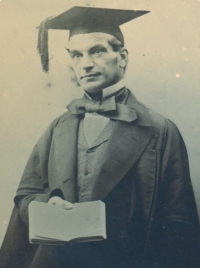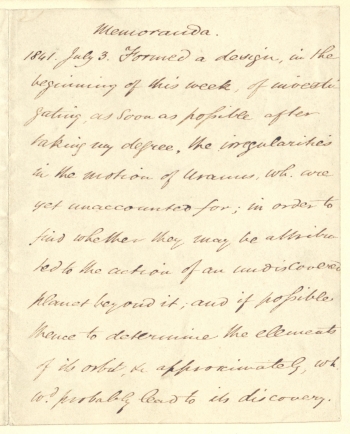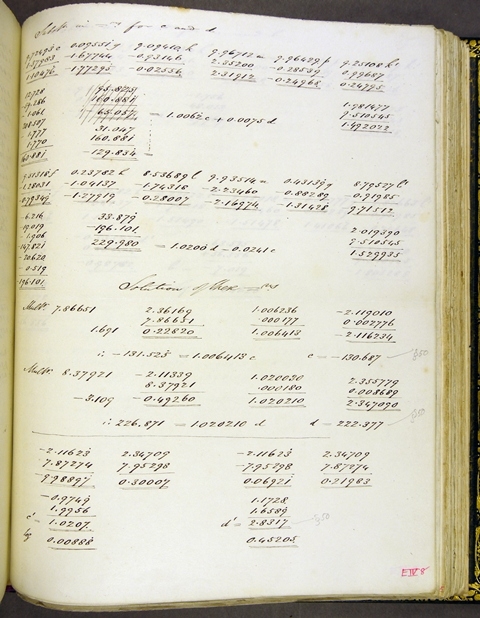Manuscripts of John Couch Adams on the perturbations of Uranus
 The bright son of a tenant farmer, John Couch Adams (1819-1892) won a sizarship to St John’s in 1839. In July 1841, at the end of his second year, he wrote himself the following memorandum: 'Formed a design ... of investigating, as soon as possible after taking my degree, the irregularities in the motion of Uranus, which are yet unaccounted for; in order to find whether they may be attributed to the action of an undiscovered planet beyond it ...'
The bright son of a tenant farmer, John Couch Adams (1819-1892) won a sizarship to St John’s in 1839. In July 1841, at the end of his second year, he wrote himself the following memorandum: 'Formed a design ... of investigating, as soon as possible after taking my degree, the irregularities in the motion of Uranus, which are yet unaccounted for; in order to find whether they may be attributed to the action of an undiscovered planet beyond it ...' 
Quite an ambitious undertaking for an undergraduate! Two years later, having graduated Senior Wrangler and been appointed to a Fellowship, Adams was able to return to his investigation of Uranus. By October 1843, aged just 24, he had arrived at a solution of the inverse perturbation problem, and although his first result was approximate, it was sufficient to convince him that the disturbances of Uranus were due to an undiscovered planet.
Further calculations followed. Having obtained more exact data on Uranus from the astronomer royal, Sir George Biddell Airy, Adams computed values for the elliptic elements, mass, and heliocentric longitude of the hypothetical planet. He gave his results to James Challis, Director of the Cambridge Observatory, in September 1845, and after two unsuccessful attempts to present his work to Airy in person, left a copy at the Royal Observatory in October. Airy replied to Adams a few weeks later but did not institute a search for the planet until July 1846.
In the meantime the French astronomer Urbain Jean Joseph Le Verrier had independently reached the same conclusions as Adams regarding an exterior planet, and published several papers. Working on Le Verrier's calculations, Johann Gottfried Galle of the Berlin Observatory discovered Neptune on 23 September 1846, less than one degree distant from where Le Verrier had predicted it would lie. Le Verrier was the astronomer who received the credit, while Adams’s earlier prediction remained unpublished. When Sir John Herschel publicised Adams’s work in a letter to the London Athenaeum, a bitter public controversy ensued over who had made the discovery first, though when Adams and Le Verrier themselves met at Oxford in 1847 they became good friends. Adams was offered a knighthood by Queen Victoria in 1847 but declined. In 1848 the Adams Prize was founded at Cambridge and the Royal Society awarded him its highest award, the Copley Medal. Adams continued to have a long and successful career in astronomy, becoming President of the Royal Astronomical Society, Lowndean Professor of Astronomy and Geometry, and Director of the Cambridge Observatory. It is, however, for his early co-discovery of the planet Neptune that he is most remembered.
The calculations that Adams made from 1841 to 1846 have been gathered together, now kept in St John’s College Library as manuscript W.16. The contents are described by R.A. Sampson in his article 'A description of Adams's manuscripts on the perturbations of Uranus', Memoirs of the Royal Astronomical Society Vol. LIV (1901), 143-170.
The Library also holds a large collection of Adams’s papers covering the whole of his long academic career, including Adams's correspondence, notes and diaries, correspondence after his death, transcripts of papers made for Donald MacAlister (Adams’s biographer), together with further biographical and miscellaneous material. A full catalogue of the papers is available online.
This Special Collections Spotlight article was contributed on 3 October 2013 by Kathryn McKee, Special Collections Librarian.
